Organisational Behaviour Report: Sainsbury's - Individual and Team
VerifiedAdded on 2023/01/18
|13
|3857
|31
Report
AI Summary
This report delves into the realm of organisational behaviour, examining the interplay of culture, power, and politics within a company, using Sainsbury's as a case study. It investigates how these factors influence individual and team performance, highlighting both positive and negative impacts. The report further explores various motivational theories, including Maslow's hierarchy of needs and process theories such as Vroom's expectancy theory, to understand how organisations can effectively motivate employees to achieve goals. Additionally, it differentiates between effective and ineffective teams, outlining the characteristics that contribute to team success. The report covers the impact of power, culture and politics on individual and team behaviour and performance. Overall, the report provides a comprehensive analysis of organisational behaviour principles and their practical application in a business setting.
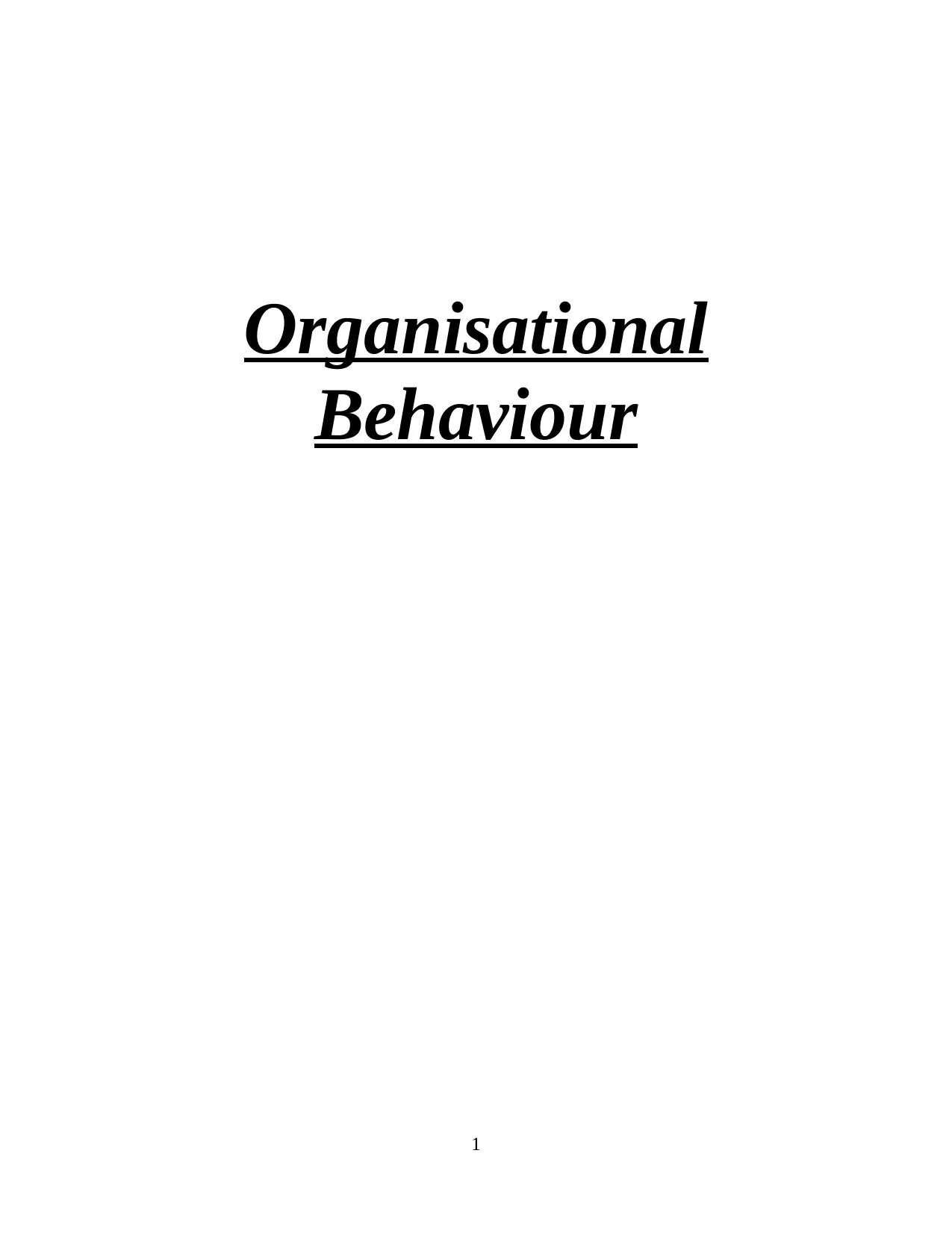
Organisational
Behaviour
1
Behaviour
1
Paraphrase This Document
Need a fresh take? Get an instant paraphrase of this document with our AI Paraphraser
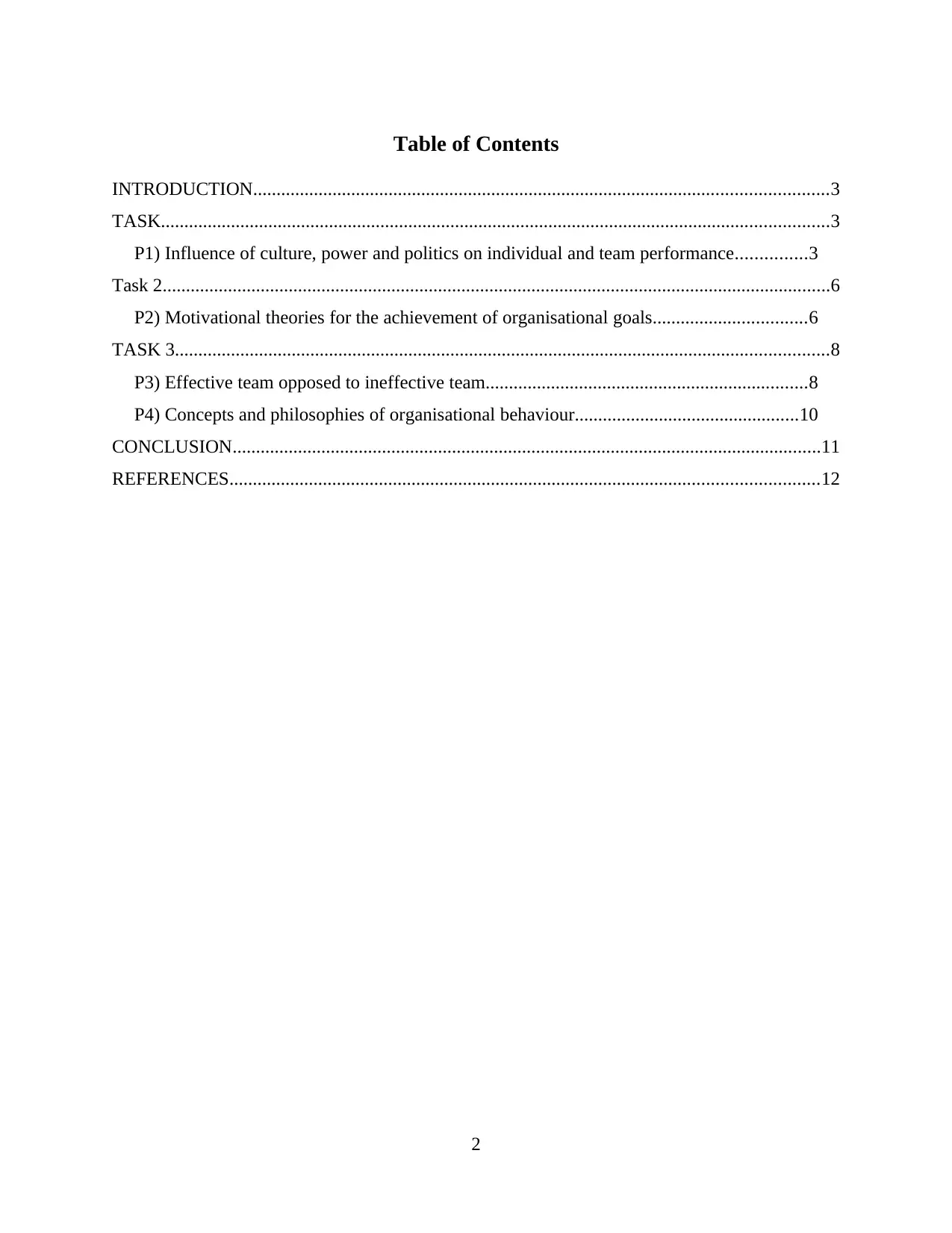
Table of Contents
INTRODUCTION...........................................................................................................................3
TASK...............................................................................................................................................3
P1) Influence of culture, power and politics on individual and team performance...............3
Task 2...............................................................................................................................................6
P2) Motivational theories for the achievement of organisational goals.................................6
TASK 3............................................................................................................................................8
P3) Effective team opposed to ineffective team.....................................................................8
P4) Concepts and philosophies of organisational behaviour................................................10
CONCLUSION..............................................................................................................................11
REFERENCES..............................................................................................................................12
2
INTRODUCTION...........................................................................................................................3
TASK...............................................................................................................................................3
P1) Influence of culture, power and politics on individual and team performance...............3
Task 2...............................................................................................................................................6
P2) Motivational theories for the achievement of organisational goals.................................6
TASK 3............................................................................................................................................8
P3) Effective team opposed to ineffective team.....................................................................8
P4) Concepts and philosophies of organisational behaviour................................................10
CONCLUSION..............................................................................................................................11
REFERENCES..............................................................................................................................12
2
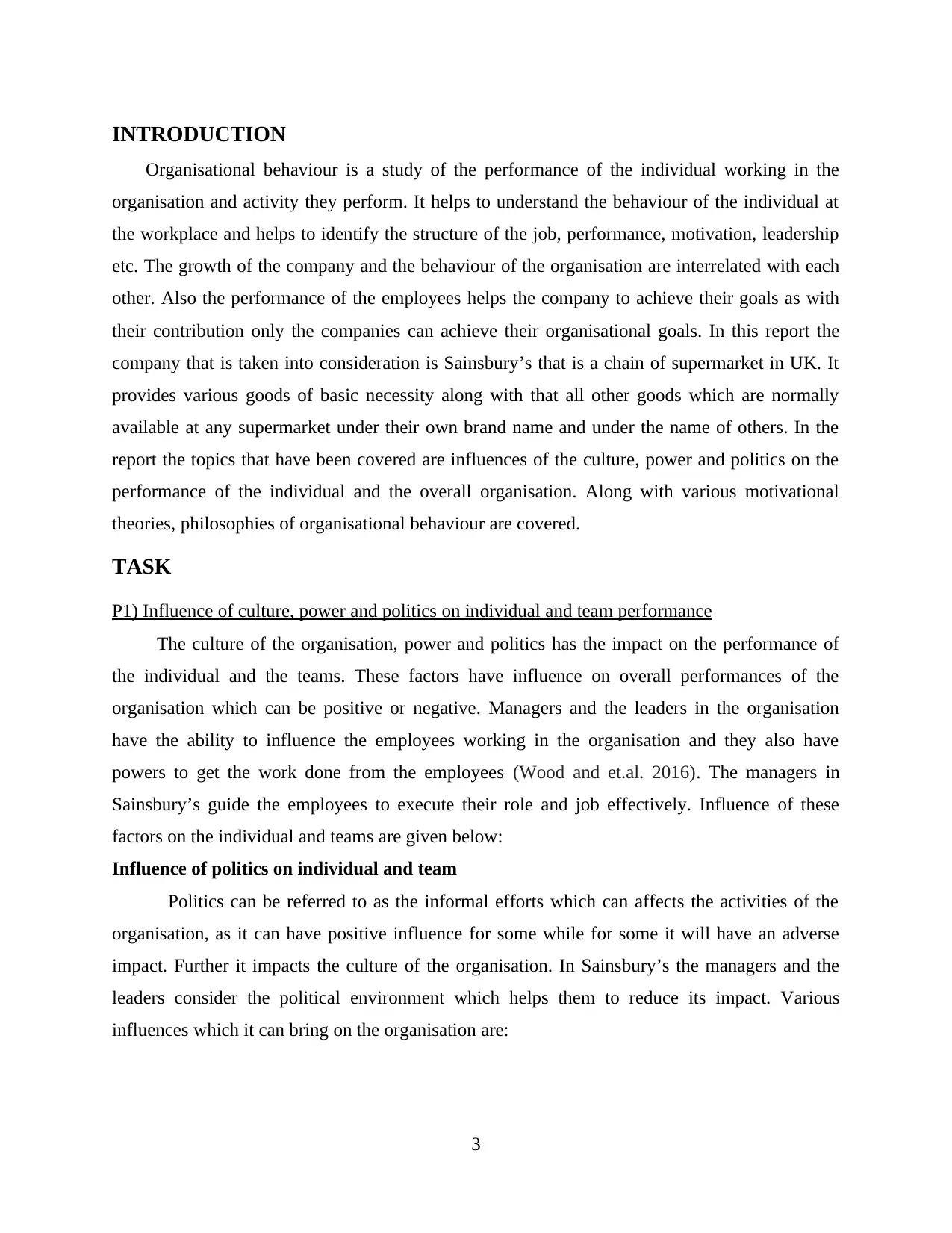
INTRODUCTION
Organisational behaviour is a study of the performance of the individual working in the
organisation and activity they perform. It helps to understand the behaviour of the individual at
the workplace and helps to identify the structure of the job, performance, motivation, leadership
etc. The growth of the company and the behaviour of the organisation are interrelated with each
other. Also the performance of the employees helps the company to achieve their goals as with
their contribution only the companies can achieve their organisational goals. In this report the
company that is taken into consideration is Sainsbury’s that is a chain of supermarket in UK. It
provides various goods of basic necessity along with that all other goods which are normally
available at any supermarket under their own brand name and under the name of others. In the
report the topics that have been covered are influences of the culture, power and politics on the
performance of the individual and the overall organisation. Along with various motivational
theories, philosophies of organisational behaviour are covered.
TASK
P1) Influence of culture, power and politics on individual and team performance
The culture of the organisation, power and politics has the impact on the performance of
the individual and the teams. These factors have influence on overall performances of the
organisation which can be positive or negative. Managers and the leaders in the organisation
have the ability to influence the employees working in the organisation and they also have
powers to get the work done from the employees (Wood and et.al. 2016). The managers in
Sainsbury’s guide the employees to execute their role and job effectively. Influence of these
factors on the individual and teams are given below:
Influence of politics on individual and team
Politics can be referred to as the informal efforts which can affects the activities of the
organisation, as it can have positive influence for some while for some it will have an adverse
impact. Further it impacts the culture of the organisation. In Sainsbury’s the managers and the
leaders consider the political environment which helps them to reduce its impact. Various
influences which it can bring on the organisation are:
3
Organisational behaviour is a study of the performance of the individual working in the
organisation and activity they perform. It helps to understand the behaviour of the individual at
the workplace and helps to identify the structure of the job, performance, motivation, leadership
etc. The growth of the company and the behaviour of the organisation are interrelated with each
other. Also the performance of the employees helps the company to achieve their goals as with
their contribution only the companies can achieve their organisational goals. In this report the
company that is taken into consideration is Sainsbury’s that is a chain of supermarket in UK. It
provides various goods of basic necessity along with that all other goods which are normally
available at any supermarket under their own brand name and under the name of others. In the
report the topics that have been covered are influences of the culture, power and politics on the
performance of the individual and the overall organisation. Along with various motivational
theories, philosophies of organisational behaviour are covered.
TASK
P1) Influence of culture, power and politics on individual and team performance
The culture of the organisation, power and politics has the impact on the performance of
the individual and the teams. These factors have influence on overall performances of the
organisation which can be positive or negative. Managers and the leaders in the organisation
have the ability to influence the employees working in the organisation and they also have
powers to get the work done from the employees (Wood and et.al. 2016). The managers in
Sainsbury’s guide the employees to execute their role and job effectively. Influence of these
factors on the individual and teams are given below:
Influence of politics on individual and team
Politics can be referred to as the informal efforts which can affects the activities of the
organisation, as it can have positive influence for some while for some it will have an adverse
impact. Further it impacts the culture of the organisation. In Sainsbury’s the managers and the
leaders consider the political environment which helps them to reduce its impact. Various
influences which it can bring on the organisation are:
3
⊘ This is a preview!⊘
Do you want full access?
Subscribe today to unlock all pages.

Trusted by 1+ million students worldwide
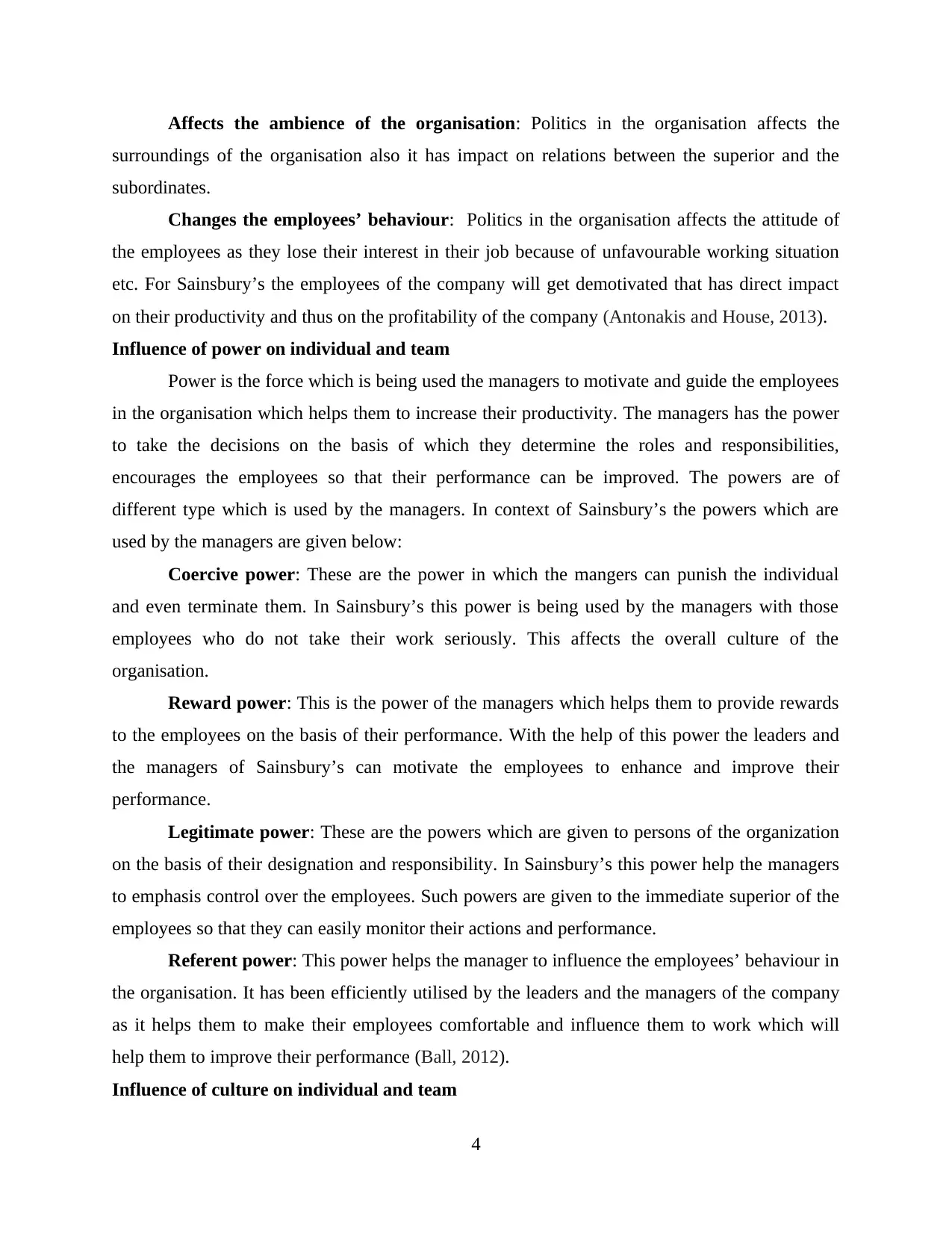
Affects the ambience of the organisation: Politics in the organisation affects the
surroundings of the organisation also it has impact on relations between the superior and the
subordinates.
Changes the employees’ behaviour: Politics in the organisation affects the attitude of
the employees as they lose their interest in their job because of unfavourable working situation
etc. For Sainsbury’s the employees of the company will get demotivated that has direct impact
on their productivity and thus on the profitability of the company (Antonakis and House, 2013).
Influence of power on individual and team
Power is the force which is being used the managers to motivate and guide the employees
in the organisation which helps them to increase their productivity. The managers has the power
to take the decisions on the basis of which they determine the roles and responsibilities,
encourages the employees so that their performance can be improved. The powers are of
different type which is used by the managers. In context of Sainsbury’s the powers which are
used by the managers are given below:
Coercive power: These are the power in which the mangers can punish the individual
and even terminate them. In Sainsbury’s this power is being used by the managers with those
employees who do not take their work seriously. This affects the overall culture of the
organisation.
Reward power: This is the power of the managers which helps them to provide rewards
to the employees on the basis of their performance. With the help of this power the leaders and
the managers of Sainsbury’s can motivate the employees to enhance and improve their
performance.
Legitimate power: These are the powers which are given to persons of the organization
on the basis of their designation and responsibility. In Sainsbury’s this power help the managers
to emphasis control over the employees. Such powers are given to the immediate superior of the
employees so that they can easily monitor their actions and performance.
Referent power: This power helps the manager to influence the employees’ behaviour in
the organisation. It has been efficiently utilised by the leaders and the managers of the company
as it helps them to make their employees comfortable and influence them to work which will
help them to improve their performance (Ball, 2012).
Influence of culture on individual and team
4
surroundings of the organisation also it has impact on relations between the superior and the
subordinates.
Changes the employees’ behaviour: Politics in the organisation affects the attitude of
the employees as they lose their interest in their job because of unfavourable working situation
etc. For Sainsbury’s the employees of the company will get demotivated that has direct impact
on their productivity and thus on the profitability of the company (Antonakis and House, 2013).
Influence of power on individual and team
Power is the force which is being used the managers to motivate and guide the employees
in the organisation which helps them to increase their productivity. The managers has the power
to take the decisions on the basis of which they determine the roles and responsibilities,
encourages the employees so that their performance can be improved. The powers are of
different type which is used by the managers. In context of Sainsbury’s the powers which are
used by the managers are given below:
Coercive power: These are the power in which the mangers can punish the individual
and even terminate them. In Sainsbury’s this power is being used by the managers with those
employees who do not take their work seriously. This affects the overall culture of the
organisation.
Reward power: This is the power of the managers which helps them to provide rewards
to the employees on the basis of their performance. With the help of this power the leaders and
the managers of Sainsbury’s can motivate the employees to enhance and improve their
performance.
Legitimate power: These are the powers which are given to persons of the organization
on the basis of their designation and responsibility. In Sainsbury’s this power help the managers
to emphasis control over the employees. Such powers are given to the immediate superior of the
employees so that they can easily monitor their actions and performance.
Referent power: This power helps the manager to influence the employees’ behaviour in
the organisation. It has been efficiently utilised by the leaders and the managers of the company
as it helps them to make their employees comfortable and influence them to work which will
help them to improve their performance (Ball, 2012).
Influence of culture on individual and team
4
Paraphrase This Document
Need a fresh take? Get an instant paraphrase of this document with our AI Paraphraser
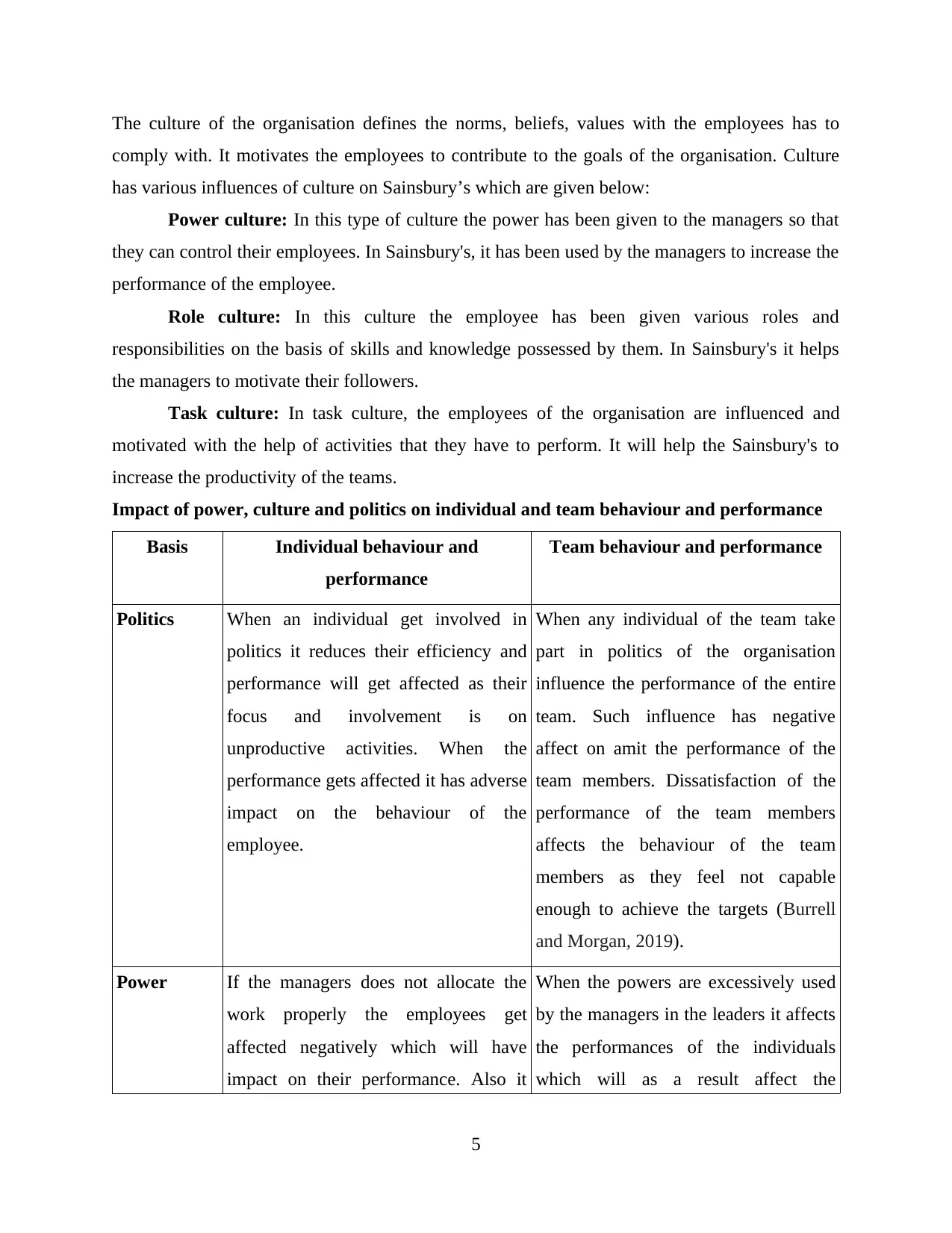
The culture of the organisation defines the norms, beliefs, values with the employees has to
comply with. It motivates the employees to contribute to the goals of the organisation. Culture
has various influences of culture on Sainsbury’s which are given below:
Power culture: In this type of culture the power has been given to the managers so that
they can control their employees. In Sainsbury's, it has been used by the managers to increase the
performance of the employee.
Role culture: In this culture the employee has been given various roles and
responsibilities on the basis of skills and knowledge possessed by them. In Sainsbury's it helps
the managers to motivate their followers.
Task culture: In task culture, the employees of the organisation are influenced and
motivated with the help of activities that they have to perform. It will help the Sainsbury's to
increase the productivity of the teams.
Impact of power, culture and politics on individual and team behaviour and performance
Basis Individual behaviour and
performance
Team behaviour and performance
Politics When an individual get involved in
politics it reduces their efficiency and
performance will get affected as their
focus and involvement is on
unproductive activities. When the
performance gets affected it has adverse
impact on the behaviour of the
employee.
When any individual of the team take
part in politics of the organisation
influence the performance of the entire
team. Such influence has negative
affect on amit the performance of the
team members. Dissatisfaction of the
performance of the team members
affects the behaviour of the team
members as they feel not capable
enough to achieve the targets (Burrell
and Morgan, 2019).
Power If the managers does not allocate the
work properly the employees get
affected negatively which will have
impact on their performance. Also it
When the powers are excessively used
by the managers in the leaders it affects
the performances of the individuals
which will as a result affect the
5
comply with. It motivates the employees to contribute to the goals of the organisation. Culture
has various influences of culture on Sainsbury’s which are given below:
Power culture: In this type of culture the power has been given to the managers so that
they can control their employees. In Sainsbury's, it has been used by the managers to increase the
performance of the employee.
Role culture: In this culture the employee has been given various roles and
responsibilities on the basis of skills and knowledge possessed by them. In Sainsbury's it helps
the managers to motivate their followers.
Task culture: In task culture, the employees of the organisation are influenced and
motivated with the help of activities that they have to perform. It will help the Sainsbury's to
increase the productivity of the teams.
Impact of power, culture and politics on individual and team behaviour and performance
Basis Individual behaviour and
performance
Team behaviour and performance
Politics When an individual get involved in
politics it reduces their efficiency and
performance will get affected as their
focus and involvement is on
unproductive activities. When the
performance gets affected it has adverse
impact on the behaviour of the
employee.
When any individual of the team take
part in politics of the organisation
influence the performance of the entire
team. Such influence has negative
affect on amit the performance of the
team members. Dissatisfaction of the
performance of the team members
affects the behaviour of the team
members as they feel not capable
enough to achieve the targets (Burrell
and Morgan, 2019).
Power If the managers does not allocate the
work properly the employees get
affected negatively which will have
impact on their performance. Also it
When the powers are excessively used
by the managers in the leaders it affects
the performances of the individuals
which will as a result affect the
5
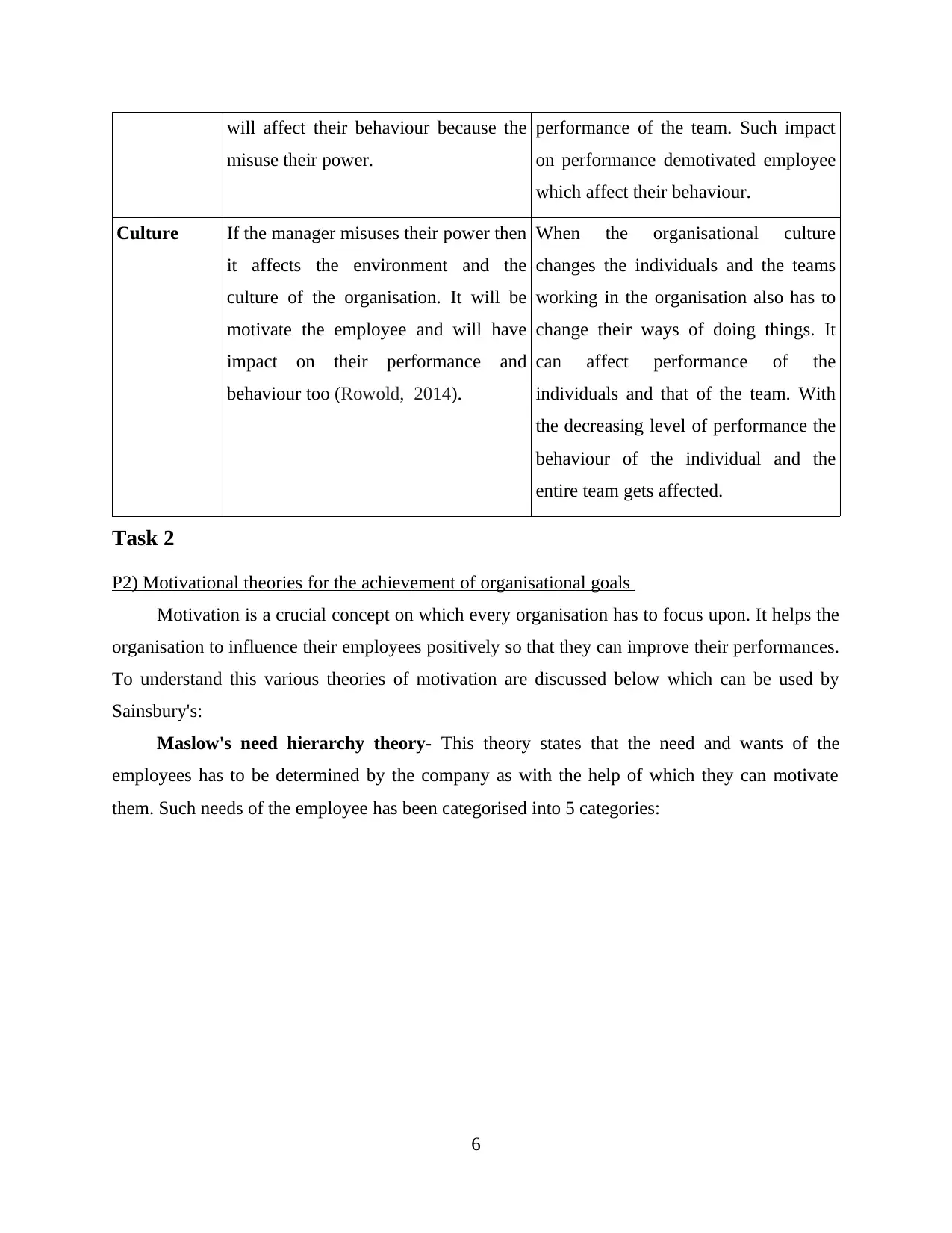
will affect their behaviour because the
misuse their power.
performance of the team. Such impact
on performance demotivated employee
which affect their behaviour.
Culture If the manager misuses their power then
it affects the environment and the
culture of the organisation. It will be
motivate the employee and will have
impact on their performance and
behaviour too (Rowold, 2014).
When the organisational culture
changes the individuals and the teams
working in the organisation also has to
change their ways of doing things. It
can affect performance of the
individuals and that of the team. With
the decreasing level of performance the
behaviour of the individual and the
entire team gets affected.
Task 2
P2) Motivational theories for the achievement of organisational goals
Motivation is a crucial concept on which every organisation has to focus upon. It helps the
organisation to influence their employees positively so that they can improve their performances.
To understand this various theories of motivation are discussed below which can be used by
Sainsbury's:
Maslow's need hierarchy theory- This theory states that the need and wants of the
employees has to be determined by the company as with the help of which they can motivate
them. Such needs of the employee has been categorised into 5 categories:
6
misuse their power.
performance of the team. Such impact
on performance demotivated employee
which affect their behaviour.
Culture If the manager misuses their power then
it affects the environment and the
culture of the organisation. It will be
motivate the employee and will have
impact on their performance and
behaviour too (Rowold, 2014).
When the organisational culture
changes the individuals and the teams
working in the organisation also has to
change their ways of doing things. It
can affect performance of the
individuals and that of the team. With
the decreasing level of performance the
behaviour of the individual and the
entire team gets affected.
Task 2
P2) Motivational theories for the achievement of organisational goals
Motivation is a crucial concept on which every organisation has to focus upon. It helps the
organisation to influence their employees positively so that they can improve their performances.
To understand this various theories of motivation are discussed below which can be used by
Sainsbury's:
Maslow's need hierarchy theory- This theory states that the need and wants of the
employees has to be determined by the company as with the help of which they can motivate
them. Such needs of the employee has been categorised into 5 categories:
6
⊘ This is a preview!⊘
Do you want full access?
Subscribe today to unlock all pages.

Trusted by 1+ million students worldwide
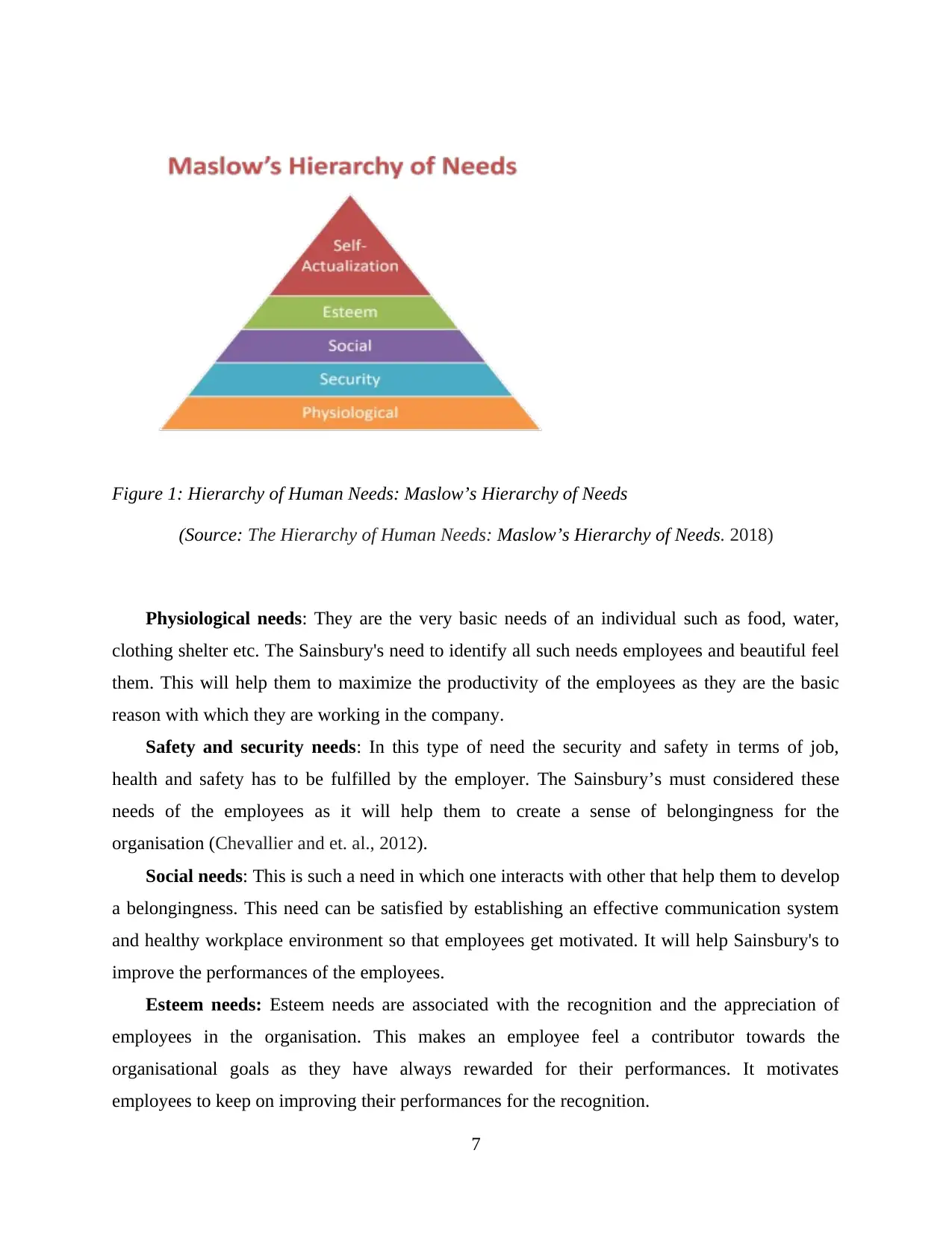
Figure 1: Hierarchy of Human Needs: Maslow’s Hierarchy of Needs
(Source: The Hierarchy of Human Needs: Maslow’s Hierarchy of Needs. 2018)
Physiological needs: They are the very basic needs of an individual such as food, water,
clothing shelter etc. The Sainsbury's need to identify all such needs employees and beautiful feel
them. This will help them to maximize the productivity of the employees as they are the basic
reason with which they are working in the company.
Safety and security needs: In this type of need the security and safety in terms of job,
health and safety has to be fulfilled by the employer. The Sainsbury’s must considered these
needs of the employees as it will help them to create a sense of belongingness for the
organisation (Chevallier and et. al., 2012).
Social needs: This is such a need in which one interacts with other that help them to develop
a belongingness. This need can be satisfied by establishing an effective communication system
and healthy workplace environment so that employees get motivated. It will help Sainsbury's to
improve the performances of the employees.
Esteem needs: Esteem needs are associated with the recognition and the appreciation of
employees in the organisation. This makes an employee feel a contributor towards the
organisational goals as they have always rewarded for their performances. It motivates
employees to keep on improving their performances for the recognition.
7
(Source: The Hierarchy of Human Needs: Maslow’s Hierarchy of Needs. 2018)
Physiological needs: They are the very basic needs of an individual such as food, water,
clothing shelter etc. The Sainsbury's need to identify all such needs employees and beautiful feel
them. This will help them to maximize the productivity of the employees as they are the basic
reason with which they are working in the company.
Safety and security needs: In this type of need the security and safety in terms of job,
health and safety has to be fulfilled by the employer. The Sainsbury’s must considered these
needs of the employees as it will help them to create a sense of belongingness for the
organisation (Chevallier and et. al., 2012).
Social needs: This is such a need in which one interacts with other that help them to develop
a belongingness. This need can be satisfied by establishing an effective communication system
and healthy workplace environment so that employees get motivated. It will help Sainsbury's to
improve the performances of the employees.
Esteem needs: Esteem needs are associated with the recognition and the appreciation of
employees in the organisation. This makes an employee feel a contributor towards the
organisational goals as they have always rewarded for their performances. It motivates
employees to keep on improving their performances for the recognition.
7
Paraphrase This Document
Need a fresh take? Get an instant paraphrase of this document with our AI Paraphraser
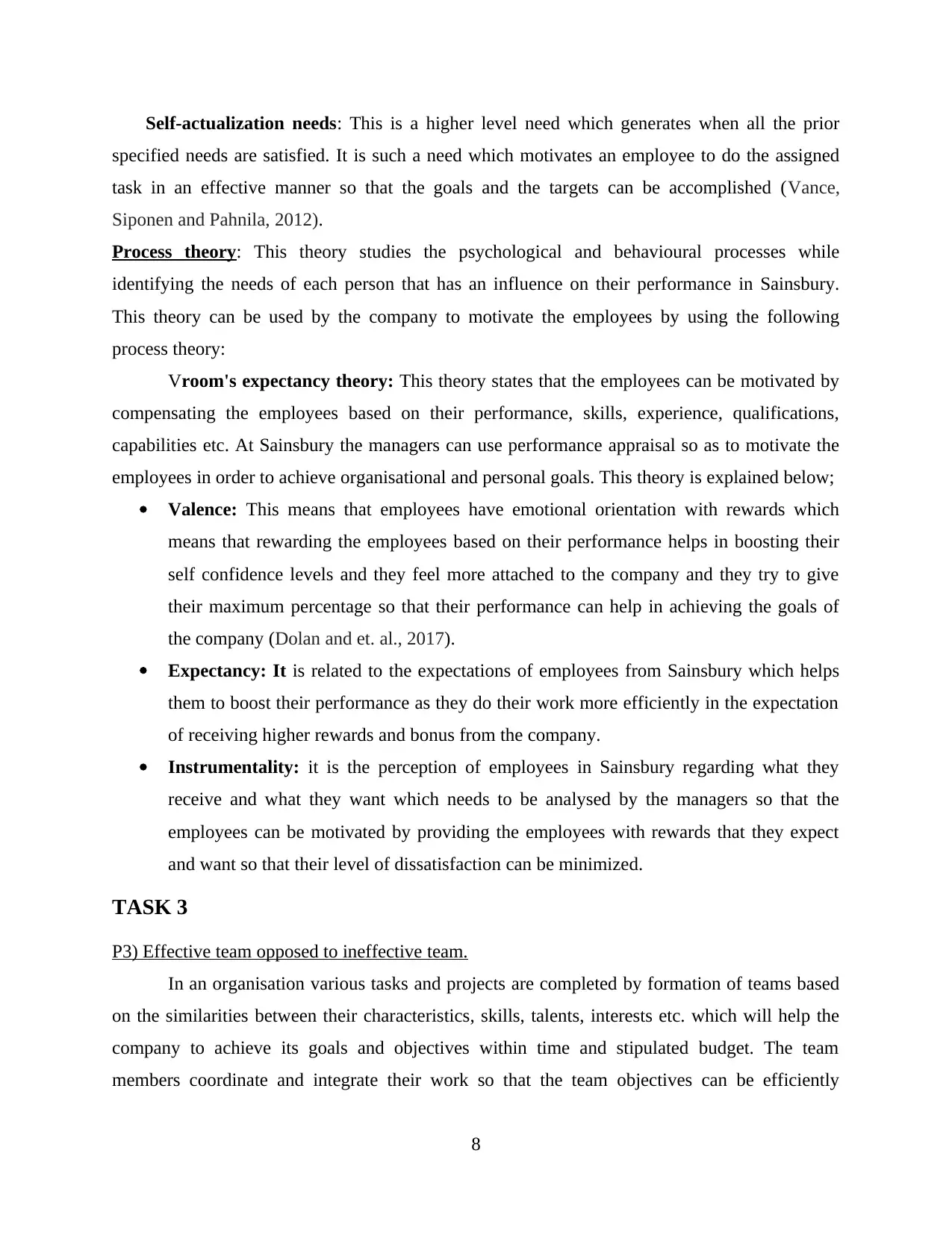
Self-actualization needs: This is a higher level need which generates when all the prior
specified needs are satisfied. It is such a need which motivates an employee to do the assigned
task in an effective manner so that the goals and the targets can be accomplished (Vance,
Siponen and Pahnila, 2012).
Process theory: This theory studies the psychological and behavioural processes while
identifying the needs of each person that has an influence on their performance in Sainsbury.
This theory can be used by the company to motivate the employees by using the following
process theory:
Vroom's expectancy theory: This theory states that the employees can be motivated by
compensating the employees based on their performance, skills, experience, qualifications,
capabilities etc. At Sainsbury the managers can use performance appraisal so as to motivate the
employees in order to achieve organisational and personal goals. This theory is explained below;
Valence: This means that employees have emotional orientation with rewards which
means that rewarding the employees based on their performance helps in boosting their
self confidence levels and they feel more attached to the company and they try to give
their maximum percentage so that their performance can help in achieving the goals of
the company (Dolan and et. al., 2017).
Expectancy: It is related to the expectations of employees from Sainsbury which helps
them to boost their performance as they do their work more efficiently in the expectation
of receiving higher rewards and bonus from the company.
Instrumentality: it is the perception of employees in Sainsbury regarding what they
receive and what they want which needs to be analysed by the managers so that the
employees can be motivated by providing the employees with rewards that they expect
and want so that their level of dissatisfaction can be minimized.
TASK 3
P3) Effective team opposed to ineffective team.
In an organisation various tasks and projects are completed by formation of teams based
on the similarities between their characteristics, skills, talents, interests etc. which will help the
company to achieve its goals and objectives within time and stipulated budget. The team
members coordinate and integrate their work so that the team objectives can be efficiently
8
specified needs are satisfied. It is such a need which motivates an employee to do the assigned
task in an effective manner so that the goals and the targets can be accomplished (Vance,
Siponen and Pahnila, 2012).
Process theory: This theory studies the psychological and behavioural processes while
identifying the needs of each person that has an influence on their performance in Sainsbury.
This theory can be used by the company to motivate the employees by using the following
process theory:
Vroom's expectancy theory: This theory states that the employees can be motivated by
compensating the employees based on their performance, skills, experience, qualifications,
capabilities etc. At Sainsbury the managers can use performance appraisal so as to motivate the
employees in order to achieve organisational and personal goals. This theory is explained below;
Valence: This means that employees have emotional orientation with rewards which
means that rewarding the employees based on their performance helps in boosting their
self confidence levels and they feel more attached to the company and they try to give
their maximum percentage so that their performance can help in achieving the goals of
the company (Dolan and et. al., 2017).
Expectancy: It is related to the expectations of employees from Sainsbury which helps
them to boost their performance as they do their work more efficiently in the expectation
of receiving higher rewards and bonus from the company.
Instrumentality: it is the perception of employees in Sainsbury regarding what they
receive and what they want which needs to be analysed by the managers so that the
employees can be motivated by providing the employees with rewards that they expect
and want so that their level of dissatisfaction can be minimized.
TASK 3
P3) Effective team opposed to ineffective team.
In an organisation various tasks and projects are completed by formation of teams based
on the similarities between their characteristics, skills, talents, interests etc. which will help the
company to achieve its goals and objectives within time and stipulated budget. The team
members coordinate and integrate their work so that the team objectives can be efficiently
8
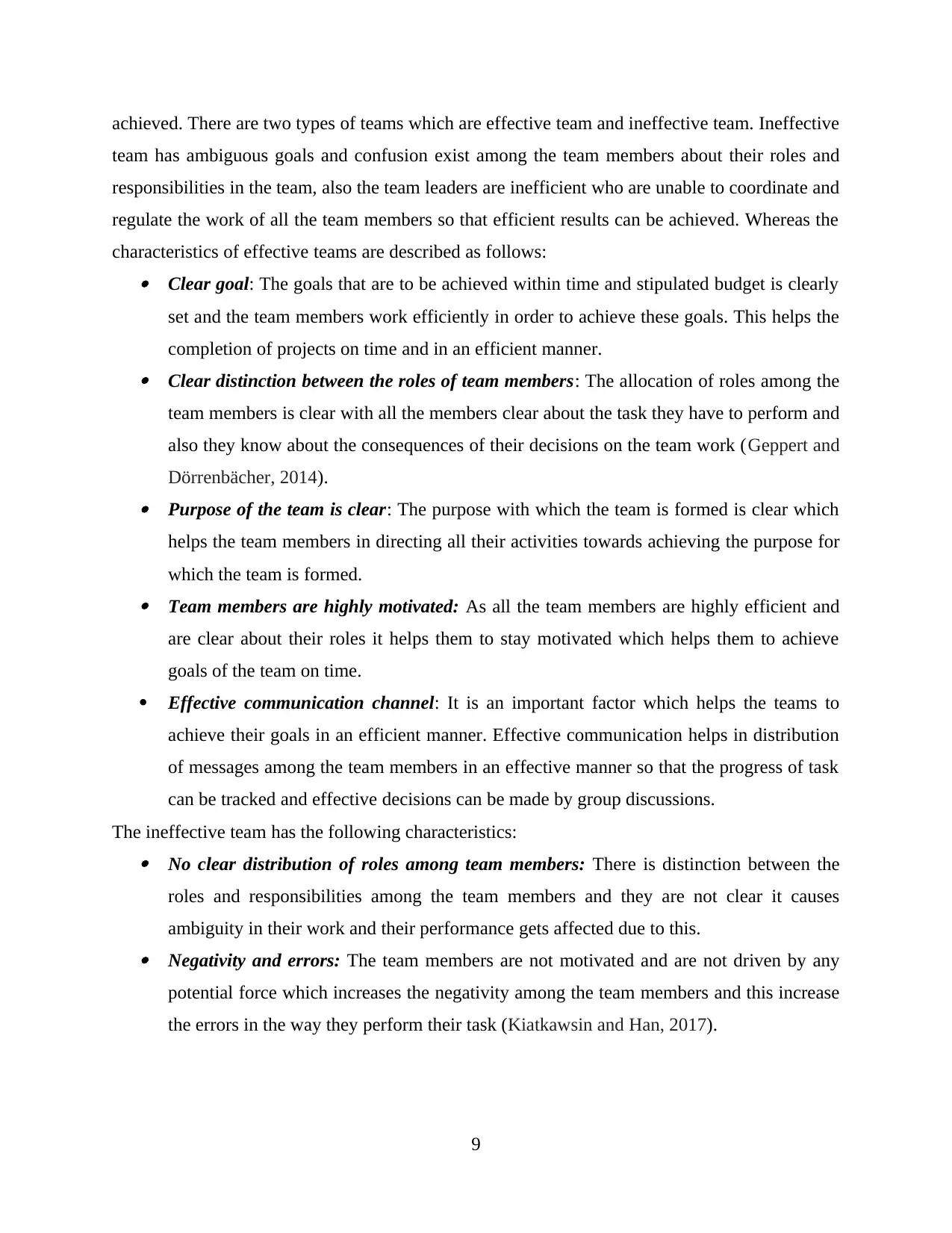
achieved. There are two types of teams which are effective team and ineffective team. Ineffective
team has ambiguous goals and confusion exist among the team members about their roles and
responsibilities in the team, also the team leaders are inefficient who are unable to coordinate and
regulate the work of all the team members so that efficient results can be achieved. Whereas the
characteristics of effective teams are described as follows: Clear goal: The goals that are to be achieved within time and stipulated budget is clearly
set and the team members work efficiently in order to achieve these goals. This helps the
completion of projects on time and in an efficient manner. Clear distinction between the roles of team members: The allocation of roles among the
team members is clear with all the members clear about the task they have to perform and
also they know about the consequences of their decisions on the team work (Geppert and
Dörrenbächer, 2014). Purpose of the team is clear: The purpose with which the team is formed is clear which
helps the team members in directing all their activities towards achieving the purpose for
which the team is formed. Team members are highly motivated: As all the team members are highly efficient and
are clear about their roles it helps them to stay motivated which helps them to achieve
goals of the team on time.
Effective communication channel: It is an important factor which helps the teams to
achieve their goals in an efficient manner. Effective communication helps in distribution
of messages among the team members in an effective manner so that the progress of task
can be tracked and effective decisions can be made by group discussions.
The ineffective team has the following characteristics: No clear distribution of roles among team members: There is distinction between the
roles and responsibilities among the team members and they are not clear it causes
ambiguity in their work and their performance gets affected due to this. Negativity and errors: The team members are not motivated and are not driven by any
potential force which increases the negativity among the team members and this increase
the errors in the way they perform their task (Kiatkawsin and Han, 2017).
9
team has ambiguous goals and confusion exist among the team members about their roles and
responsibilities in the team, also the team leaders are inefficient who are unable to coordinate and
regulate the work of all the team members so that efficient results can be achieved. Whereas the
characteristics of effective teams are described as follows: Clear goal: The goals that are to be achieved within time and stipulated budget is clearly
set and the team members work efficiently in order to achieve these goals. This helps the
completion of projects on time and in an efficient manner. Clear distinction between the roles of team members: The allocation of roles among the
team members is clear with all the members clear about the task they have to perform and
also they know about the consequences of their decisions on the team work (Geppert and
Dörrenbächer, 2014). Purpose of the team is clear: The purpose with which the team is formed is clear which
helps the team members in directing all their activities towards achieving the purpose for
which the team is formed. Team members are highly motivated: As all the team members are highly efficient and
are clear about their roles it helps them to stay motivated which helps them to achieve
goals of the team on time.
Effective communication channel: It is an important factor which helps the teams to
achieve their goals in an efficient manner. Effective communication helps in distribution
of messages among the team members in an effective manner so that the progress of task
can be tracked and effective decisions can be made by group discussions.
The ineffective team has the following characteristics: No clear distribution of roles among team members: There is distinction between the
roles and responsibilities among the team members and they are not clear it causes
ambiguity in their work and their performance gets affected due to this. Negativity and errors: The team members are not motivated and are not driven by any
potential force which increases the negativity among the team members and this increase
the errors in the way they perform their task (Kiatkawsin and Han, 2017).
9
⊘ This is a preview!⊘
Do you want full access?
Subscribe today to unlock all pages.

Trusted by 1+ million students worldwide
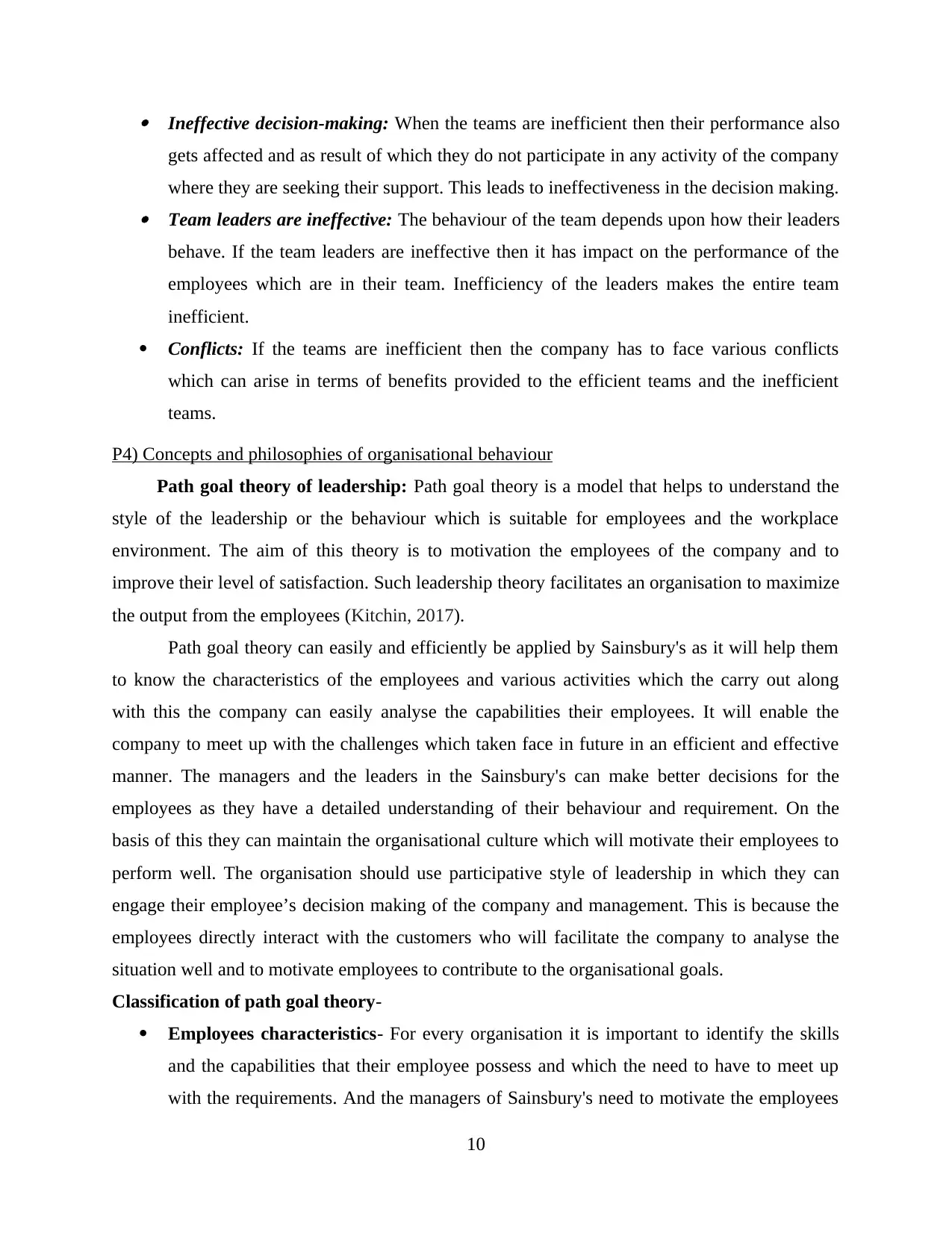
Ineffective decision-making: When the teams are inefficient then their performance also
gets affected and as result of which they do not participate in any activity of the company
where they are seeking their support. This leads to ineffectiveness in the decision making. Team leaders are ineffective: The behaviour of the team depends upon how their leaders
behave. If the team leaders are ineffective then it has impact on the performance of the
employees which are in their team. Inefficiency of the leaders makes the entire team
inefficient.
Conflicts: If the teams are inefficient then the company has to face various conflicts
which can arise in terms of benefits provided to the efficient teams and the inefficient
teams.
P4) Concepts and philosophies of organisational behaviour
Path goal theory of leadership: Path goal theory is a model that helps to understand the
style of the leadership or the behaviour which is suitable for employees and the workplace
environment. The aim of this theory is to motivation the employees of the company and to
improve their level of satisfaction. Such leadership theory facilitates an organisation to maximize
the output from the employees (Kitchin, 2017).
Path goal theory can easily and efficiently be applied by Sainsbury's as it will help them
to know the characteristics of the employees and various activities which the carry out along
with this the company can easily analyse the capabilities their employees. It will enable the
company to meet up with the challenges which taken face in future in an efficient and effective
manner. The managers and the leaders in the Sainsbury's can make better decisions for the
employees as they have a detailed understanding of their behaviour and requirement. On the
basis of this they can maintain the organisational culture which will motivate their employees to
perform well. The organisation should use participative style of leadership in which they can
engage their employee’s decision making of the company and management. This is because the
employees directly interact with the customers who will facilitate the company to analyse the
situation well and to motivate employees to contribute to the organisational goals.
Classification of path goal theory-
Employees characteristics- For every organisation it is important to identify the skills
and the capabilities that their employee possess and which the need to have to meet up
with the requirements. And the managers of Sainsbury's need to motivate the employees
10
gets affected and as result of which they do not participate in any activity of the company
where they are seeking their support. This leads to ineffectiveness in the decision making. Team leaders are ineffective: The behaviour of the team depends upon how their leaders
behave. If the team leaders are ineffective then it has impact on the performance of the
employees which are in their team. Inefficiency of the leaders makes the entire team
inefficient.
Conflicts: If the teams are inefficient then the company has to face various conflicts
which can arise in terms of benefits provided to the efficient teams and the inefficient
teams.
P4) Concepts and philosophies of organisational behaviour
Path goal theory of leadership: Path goal theory is a model that helps to understand the
style of the leadership or the behaviour which is suitable for employees and the workplace
environment. The aim of this theory is to motivation the employees of the company and to
improve their level of satisfaction. Such leadership theory facilitates an organisation to maximize
the output from the employees (Kitchin, 2017).
Path goal theory can easily and efficiently be applied by Sainsbury's as it will help them
to know the characteristics of the employees and various activities which the carry out along
with this the company can easily analyse the capabilities their employees. It will enable the
company to meet up with the challenges which taken face in future in an efficient and effective
manner. The managers and the leaders in the Sainsbury's can make better decisions for the
employees as they have a detailed understanding of their behaviour and requirement. On the
basis of this they can maintain the organisational culture which will motivate their employees to
perform well. The organisation should use participative style of leadership in which they can
engage their employee’s decision making of the company and management. This is because the
employees directly interact with the customers who will facilitate the company to analyse the
situation well and to motivate employees to contribute to the organisational goals.
Classification of path goal theory-
Employees characteristics- For every organisation it is important to identify the skills
and the capabilities that their employee possess and which the need to have to meet up
with the requirements. And the managers of Sainsbury's need to motivate the employees
10
Paraphrase This Document
Need a fresh take? Get an instant paraphrase of this document with our AI Paraphraser
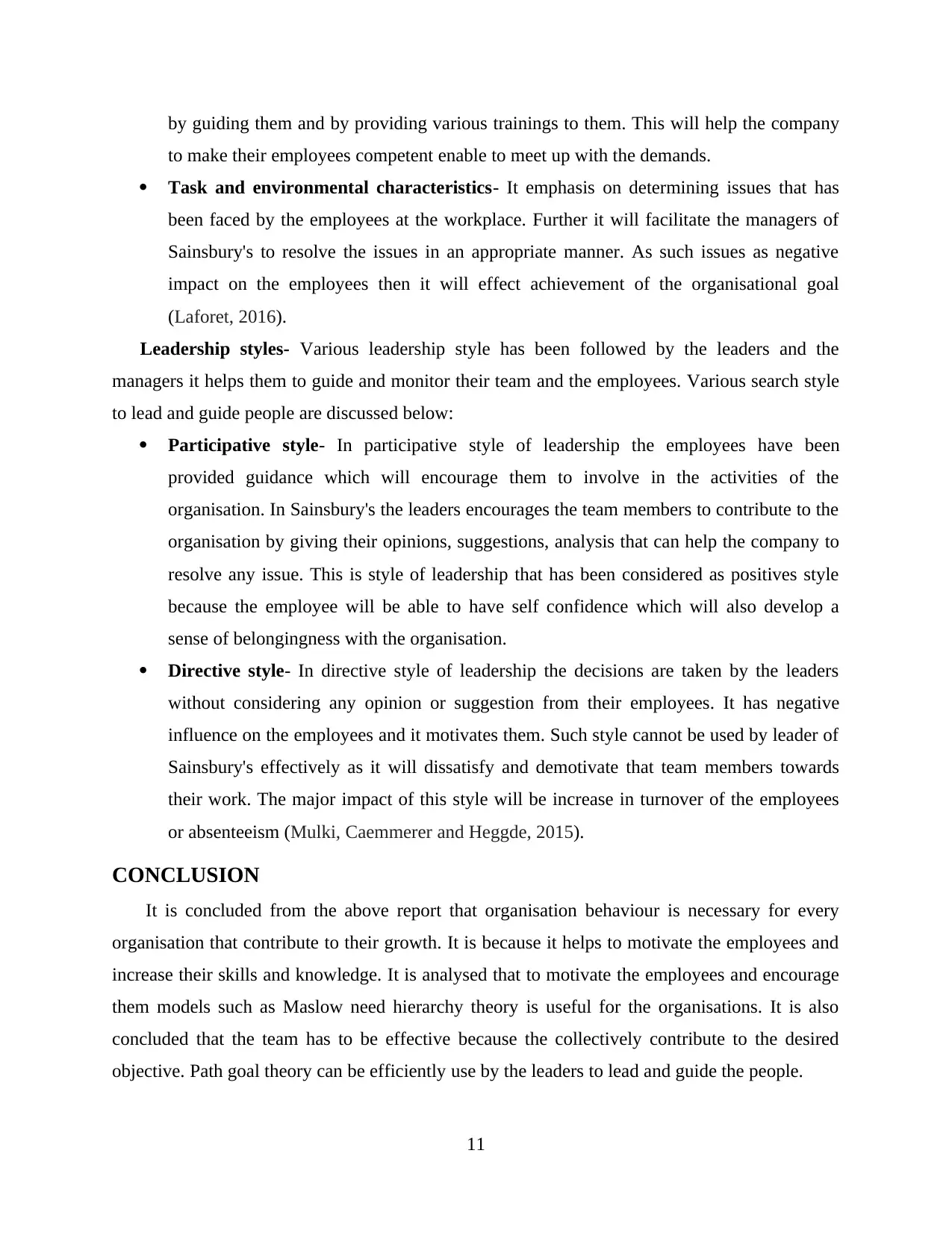
by guiding them and by providing various trainings to them. This will help the company
to make their employees competent enable to meet up with the demands.
Task and environmental characteristics- It emphasis on determining issues that has
been faced by the employees at the workplace. Further it will facilitate the managers of
Sainsbury's to resolve the issues in an appropriate manner. As such issues as negative
impact on the employees then it will effect achievement of the organisational goal
(Laforet, 2016).
Leadership styles- Various leadership style has been followed by the leaders and the
managers it helps them to guide and monitor their team and the employees. Various search style
to lead and guide people are discussed below:
Participative style- In participative style of leadership the employees have been
provided guidance which will encourage them to involve in the activities of the
organisation. In Sainsbury's the leaders encourages the team members to contribute to the
organisation by giving their opinions, suggestions, analysis that can help the company to
resolve any issue. This is style of leadership that has been considered as positives style
because the employee will be able to have self confidence which will also develop a
sense of belongingness with the organisation.
Directive style- In directive style of leadership the decisions are taken by the leaders
without considering any opinion or suggestion from their employees. It has negative
influence on the employees and it motivates them. Such style cannot be used by leader of
Sainsbury's effectively as it will dissatisfy and demotivate that team members towards
their work. The major impact of this style will be increase in turnover of the employees
or absenteeism (Mulki, Caemmerer and Heggde, 2015).
CONCLUSION
It is concluded from the above report that organisation behaviour is necessary for every
organisation that contribute to their growth. It is because it helps to motivate the employees and
increase their skills and knowledge. It is analysed that to motivate the employees and encourage
them models such as Maslow need hierarchy theory is useful for the organisations. It is also
concluded that the team has to be effective because the collectively contribute to the desired
objective. Path goal theory can be efficiently use by the leaders to lead and guide the people.
11
to make their employees competent enable to meet up with the demands.
Task and environmental characteristics- It emphasis on determining issues that has
been faced by the employees at the workplace. Further it will facilitate the managers of
Sainsbury's to resolve the issues in an appropriate manner. As such issues as negative
impact on the employees then it will effect achievement of the organisational goal
(Laforet, 2016).
Leadership styles- Various leadership style has been followed by the leaders and the
managers it helps them to guide and monitor their team and the employees. Various search style
to lead and guide people are discussed below:
Participative style- In participative style of leadership the employees have been
provided guidance which will encourage them to involve in the activities of the
organisation. In Sainsbury's the leaders encourages the team members to contribute to the
organisation by giving their opinions, suggestions, analysis that can help the company to
resolve any issue. This is style of leadership that has been considered as positives style
because the employee will be able to have self confidence which will also develop a
sense of belongingness with the organisation.
Directive style- In directive style of leadership the decisions are taken by the leaders
without considering any opinion or suggestion from their employees. It has negative
influence on the employees and it motivates them. Such style cannot be used by leader of
Sainsbury's effectively as it will dissatisfy and demotivate that team members towards
their work. The major impact of this style will be increase in turnover of the employees
or absenteeism (Mulki, Caemmerer and Heggde, 2015).
CONCLUSION
It is concluded from the above report that organisation behaviour is necessary for every
organisation that contribute to their growth. It is because it helps to motivate the employees and
increase their skills and knowledge. It is analysed that to motivate the employees and encourage
them models such as Maslow need hierarchy theory is useful for the organisations. It is also
concluded that the team has to be effective because the collectively contribute to the desired
objective. Path goal theory can be efficiently use by the leaders to lead and guide the people.
11
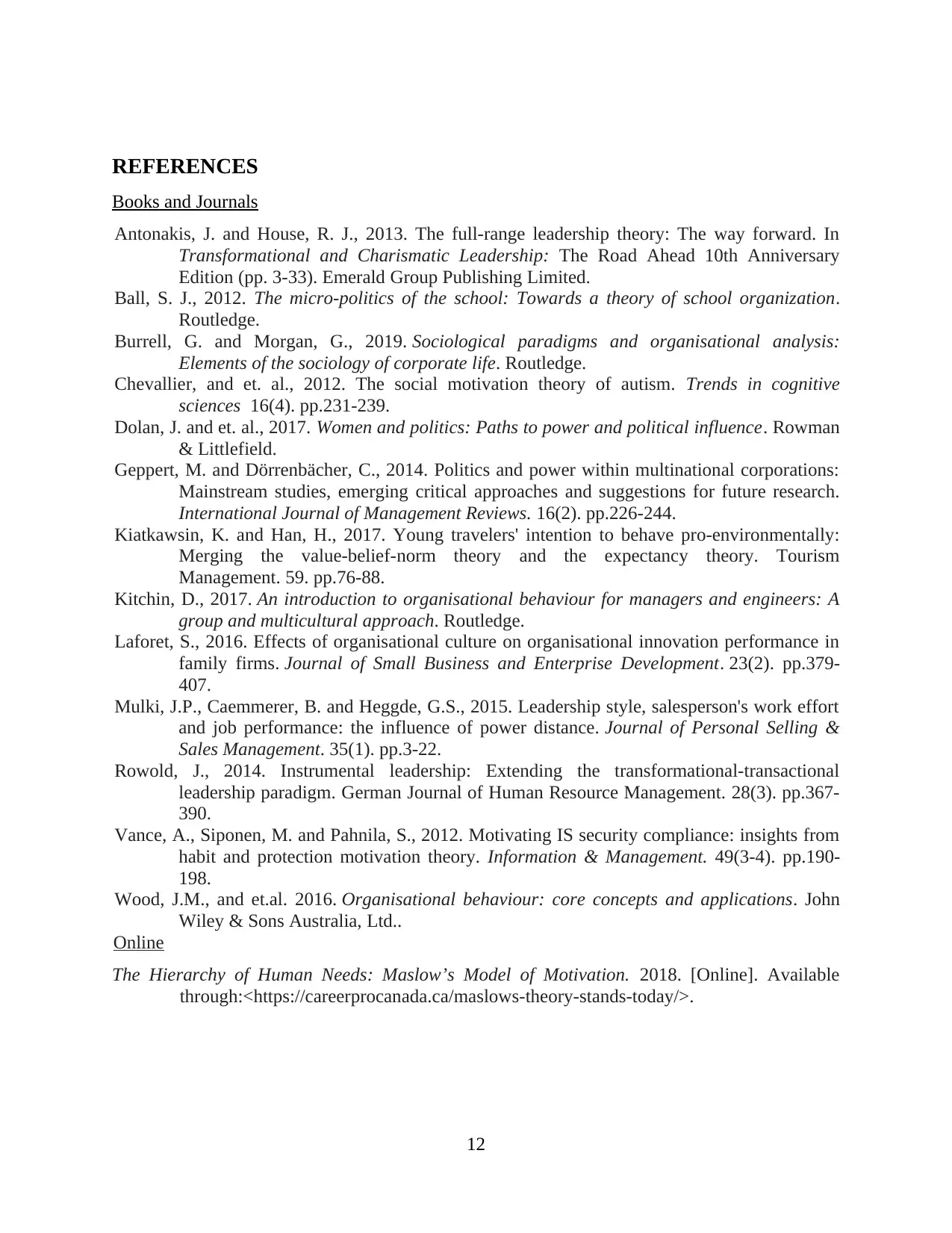
REFERENCES
Books and Journals
Antonakis, J. and House, R. J., 2013. The full-range leadership theory: The way forward. In
Transformational and Charismatic Leadership: The Road Ahead 10th Anniversary
Edition (pp. 3-33). Emerald Group Publishing Limited.
Ball, S. J., 2012. The micro-politics of the school: Towards a theory of school organization.
Routledge.
Burrell, G. and Morgan, G., 2019. Sociological paradigms and organisational analysis:
Elements of the sociology of corporate life. Routledge.
Chevallier, and et. al., 2012. The social motivation theory of autism. Trends in cognitive
sciences 16(4). pp.231-239.
Dolan, J. and et. al., 2017. Women and politics: Paths to power and political influence. Rowman
& Littlefield.
Geppert, M. and Dörrenbächer, C., 2014. Politics and power within multinational corporations:
Mainstream studies, emerging critical approaches and suggestions for future research.
International Journal of Management Reviews. 16(2). pp.226-244.
Kiatkawsin, K. and Han, H., 2017. Young travelers' intention to behave pro-environmentally:
Merging the value-belief-norm theory and the expectancy theory. Tourism
Management. 59. pp.76-88.
Kitchin, D., 2017. An introduction to organisational behaviour for managers and engineers: A
group and multicultural approach. Routledge.
Laforet, S., 2016. Effects of organisational culture on organisational innovation performance in
family firms. Journal of Small Business and Enterprise Development. 23(2). pp.379-
407.
Mulki, J.P., Caemmerer, B. and Heggde, G.S., 2015. Leadership style, salesperson's work effort
and job performance: the influence of power distance. Journal of Personal Selling &
Sales Management. 35(1). pp.3-22.
Rowold, J., 2014. Instrumental leadership: Extending the transformational-transactional
leadership paradigm. German Journal of Human Resource Management. 28(3). pp.367-
390.
Vance, A., Siponen, M. and Pahnila, S., 2012. Motivating IS security compliance: insights from
habit and protection motivation theory. Information & Management. 49(3-4). pp.190-
198.
Wood, J.M., and et.al. 2016. Organisational behaviour: core concepts and applications. John
Wiley & Sons Australia, Ltd..
Online
The Hierarchy of Human Needs: Maslow’s Model of Motivation. 2018. [Online]. Available
through:<https://careerprocanada.ca/maslows-theory-stands-today/>.
12
Books and Journals
Antonakis, J. and House, R. J., 2013. The full-range leadership theory: The way forward. In
Transformational and Charismatic Leadership: The Road Ahead 10th Anniversary
Edition (pp. 3-33). Emerald Group Publishing Limited.
Ball, S. J., 2012. The micro-politics of the school: Towards a theory of school organization.
Routledge.
Burrell, G. and Morgan, G., 2019. Sociological paradigms and organisational analysis:
Elements of the sociology of corporate life. Routledge.
Chevallier, and et. al., 2012. The social motivation theory of autism. Trends in cognitive
sciences 16(4). pp.231-239.
Dolan, J. and et. al., 2017. Women and politics: Paths to power and political influence. Rowman
& Littlefield.
Geppert, M. and Dörrenbächer, C., 2014. Politics and power within multinational corporations:
Mainstream studies, emerging critical approaches and suggestions for future research.
International Journal of Management Reviews. 16(2). pp.226-244.
Kiatkawsin, K. and Han, H., 2017. Young travelers' intention to behave pro-environmentally:
Merging the value-belief-norm theory and the expectancy theory. Tourism
Management. 59. pp.76-88.
Kitchin, D., 2017. An introduction to organisational behaviour for managers and engineers: A
group and multicultural approach. Routledge.
Laforet, S., 2016. Effects of organisational culture on organisational innovation performance in
family firms. Journal of Small Business and Enterprise Development. 23(2). pp.379-
407.
Mulki, J.P., Caemmerer, B. and Heggde, G.S., 2015. Leadership style, salesperson's work effort
and job performance: the influence of power distance. Journal of Personal Selling &
Sales Management. 35(1). pp.3-22.
Rowold, J., 2014. Instrumental leadership: Extending the transformational-transactional
leadership paradigm. German Journal of Human Resource Management. 28(3). pp.367-
390.
Vance, A., Siponen, M. and Pahnila, S., 2012. Motivating IS security compliance: insights from
habit and protection motivation theory. Information & Management. 49(3-4). pp.190-
198.
Wood, J.M., and et.al. 2016. Organisational behaviour: core concepts and applications. John
Wiley & Sons Australia, Ltd..
Online
The Hierarchy of Human Needs: Maslow’s Model of Motivation. 2018. [Online]. Available
through:<https://careerprocanada.ca/maslows-theory-stands-today/>.
12
⊘ This is a preview!⊘
Do you want full access?
Subscribe today to unlock all pages.

Trusted by 1+ million students worldwide
1 out of 13
Related Documents
Your All-in-One AI-Powered Toolkit for Academic Success.
+13062052269
info@desklib.com
Available 24*7 on WhatsApp / Email
![[object Object]](/_next/static/media/star-bottom.7253800d.svg)
Unlock your academic potential
Copyright © 2020–2025 A2Z Services. All Rights Reserved. Developed and managed by ZUCOL.





